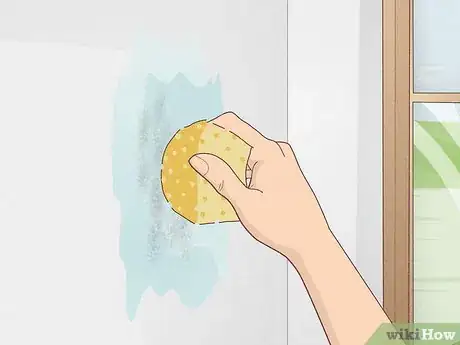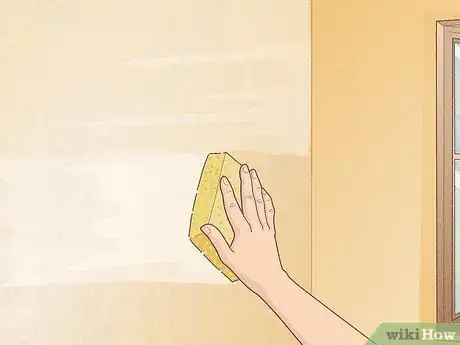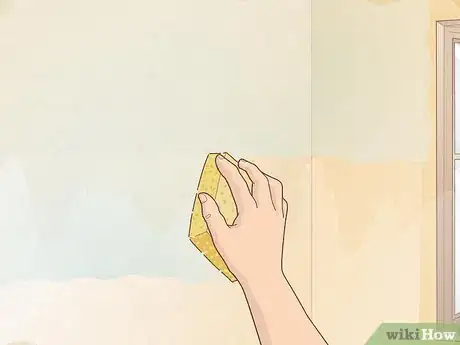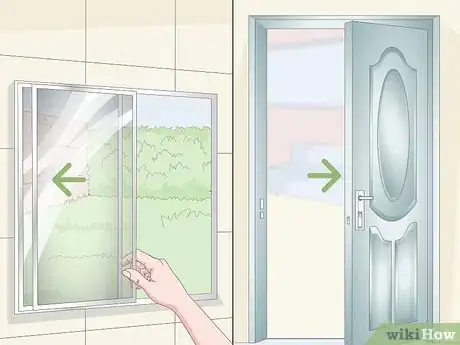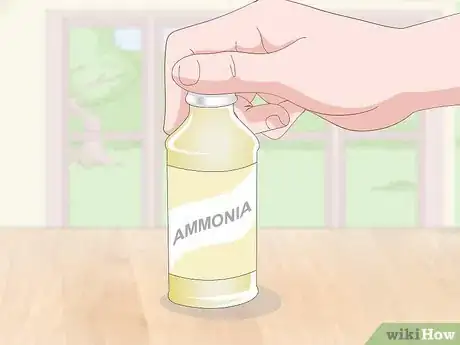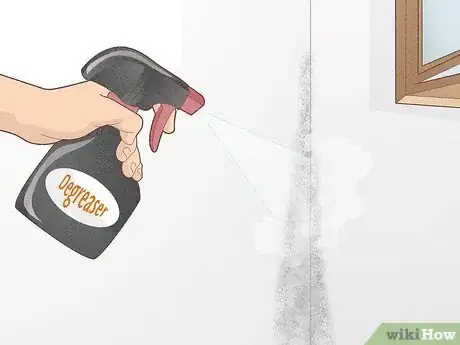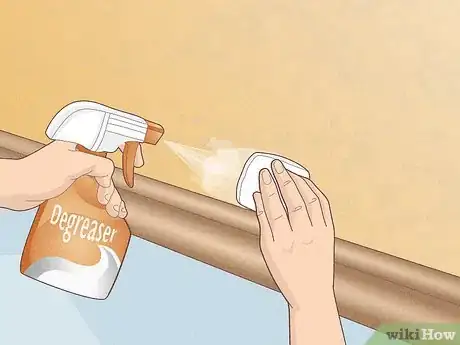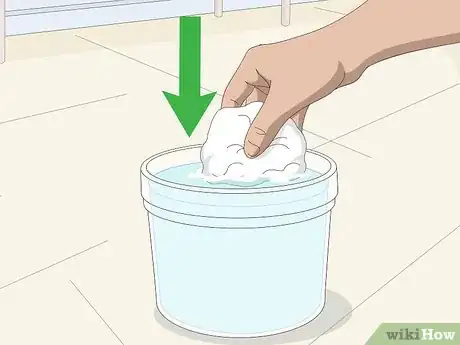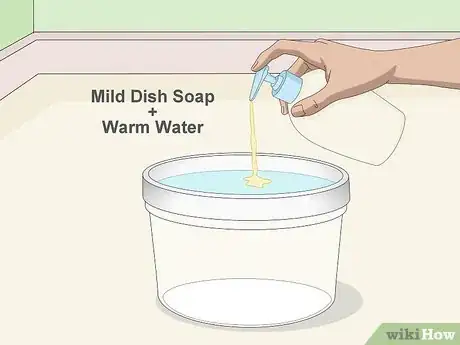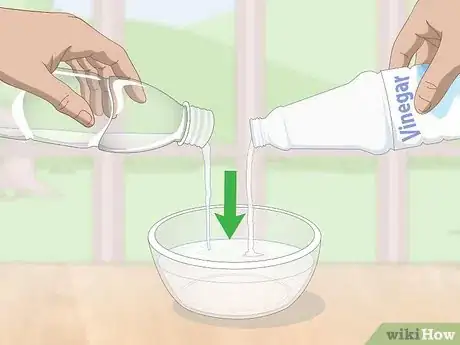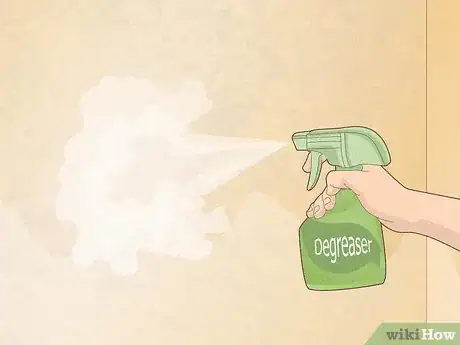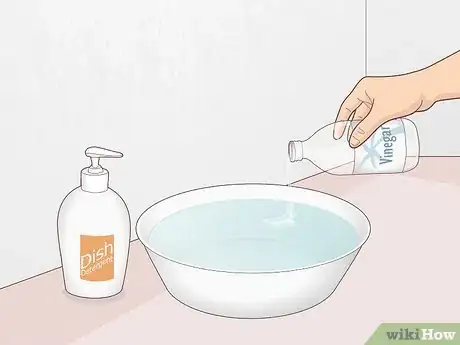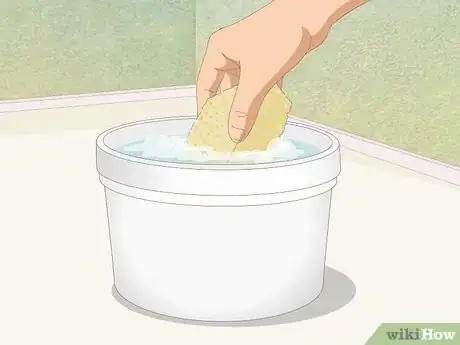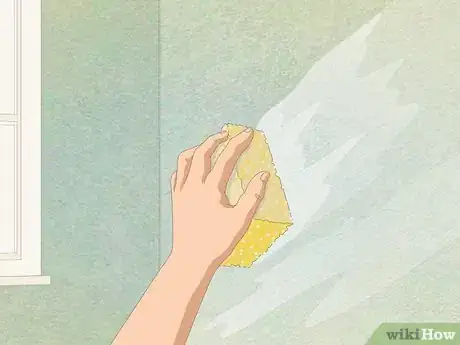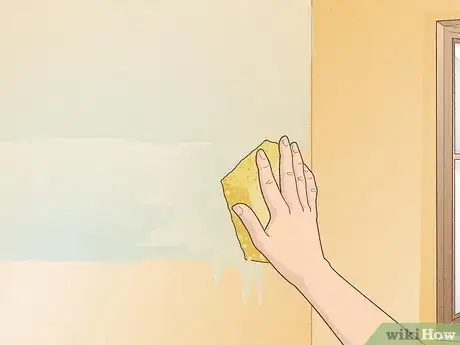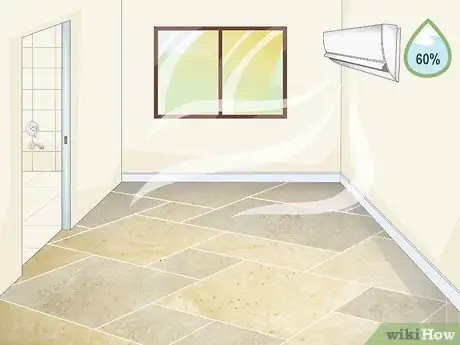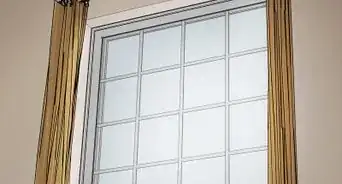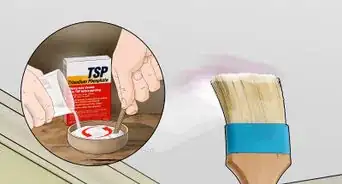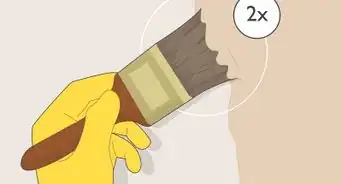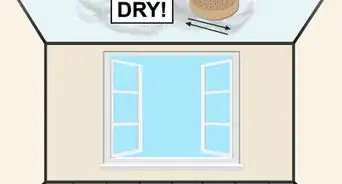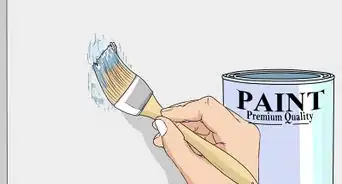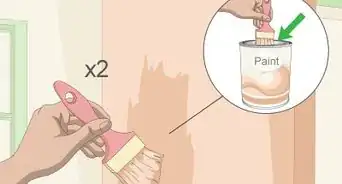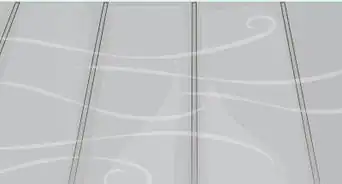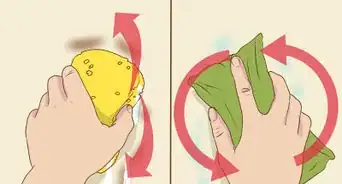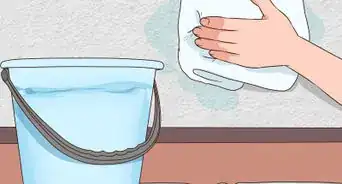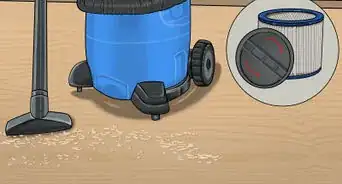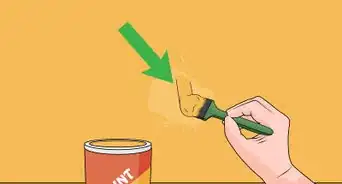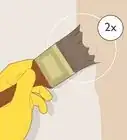This article was co-authored by Daniel Olin and by wikiHow staff writer, Hannah Madden. Daniel Olin is a Home Cleaning Specialist and the CEO of Easyway Maid Service, a home-cleaning company based in Austin, Texas. With over four years of experience, Daniel and Easyway Maid Service specialize in executive-quality maid service, as well as vacation rental cleaning and overall home deep cleaning. Daniel holds a BA in Psychology from The University of California, Los Angeles.
This article has been viewed 84,634 times.
Washing your walls is a fantastic way to deep clean and refresh your home. Although it can be a bit time consuming, cleaning painted walls is a relatively easy and straightforward task. In order to choose the best method, you will need to know what type of finish you’re working with. Consider washing your walls in the late spring or early fall, when open windows can help with the drying process.
Steps
Cleaning Matte Walls
-
1Mix a few drops of dish detergent in a 0.5 gallons (1,900 ml) of water. Choose a gentle dish detergent that is free from dyes.[1] After mixing a few drops with about 0.5 gallons (1,900 ml) of warm water, soak a sponge in the solution.
- Another option is to mix 2–3 tablespoons (30–44 ml) of white vinegar with 1 gallon (3,800 ml) of warm water.
-
2Wring the sponge out completely. It is very easy to leave streaks on flat and eggshell/satin walls. This means you want to use as little cleansing solution as possible. After soaking the sponge in the solution of your choice, wring it out until it’s just about dry.[2]
- Never use scrubby sponges or rough materials.[3]
- A soft cellulose sponge will work best.
Advertisement -
3Start at the top, left-hand side of your wall. Rub your soft, barely-wet sponge over the wall. Work from top to bottom. Move to the right and do another vertical area. Make your way across the wall in this pattern.[4]
- Remoisten and wring out your sponge as needed.
- You may need a chair or step-stool to reach the top of your wall.
-
4Make a second pass. Since you are using a very gentle solution, one pass may not get your wall completely clean. If your wall was pretty dirty to begin with, it is a good idea to do a second pass. Pause and make some fresh solution. Begin again at the top left corner of your wall.[5]
- Your solution is diluted enough that you shouldn’t need to rinse it off.
-
5Let your wall air-dry.[6] Open some windows and/or doors. Turn on a fan. Give your wall plenty of time to air dry. Avoid drying your wall with towels, as this is more likely to leave streaks.
- If possible, wash your walls when it is warm outside.
-
6Avoid harsh chemicals on flat and eggshell finishes. Both flat and eggshell (also called satin) latex paints look nice on interior walls because they don’t bounce a lot of light. Unfortunately, these popular paint finishes can be finicky to clean. These finishes can be damaged easily, so do not use chemicals or degreasers on this kind of paint.[7]
Spot-Cleaning Smudges and Stains
-
1
-
2Do a spot test. To prevent damage to your walls, it is a really good idea to do a spot test in a not-so-visible location, such as inside a cabinet. Try a few different cleansers. Simply apply the cleanser to wall, scrub, and wait to see if it has caused discoloration, streaking, or other damage.[10]
-
3Start with water on a soft sponge. To remove a stain from your walls, try just warm water first. Dampen a soft sponge, wring it out very well, and wipe down your wall. Sometimes a bit of water and elbow grease are all you need.[11]
-
4Use water and mild detergent. Combine 1-2 drops of dish detergent in about 1 quart (950 ml) of warm water. Soak and wring out a soft sponge. Use the sponge to remove the stain. Repeat this method until your wall is clean.[12]
- The detergent is so diluted that it shouldn't need to be rinsed off.
- If your spot test left a residue, try rinsing with clean water to see if this takes care of it.
-
5Mix ammonia, vinegar, baking soda, and water. Add 1 cup (240 ml) of ammonia, 0.5 cups (120 ml) of vinegar, and 0.25 cups (59 ml) of baking soda to 1 gallon (3,800 ml) of warm water. For tough stains, soak a soft sponge in this solution, and wring it dry. Use this sponge to remove any stains from your wall. Repeat this method until the stain is gone.[13]
- Always perform a spot test before using this cleanser.
- This cleanser will work best on gloss/semigloss walls.
- You can use an all-purpose cleaner with a little Bar Keepers Friend to remove crayon marks.[14]
- If you cannot clean the stain without taking off a lot of paint, it may be better to paint over the area.[15]
Cleaning Glossy Walls
-
1Use a mild degreaser in your kitchen. Gloss and semigloss paints can stand up a bit better to cleaning, which is why these paints are more popular for kitchens. If your kitchen--especially the area around your stove--has gotten covered in food splatter, a mild degreaser is a great option. Gently spray the area with the degreaser product, then wipe it down with a slightly damp sponge.[16]
- For best results, follow this with a dish detergent and vinegar solution, or simply a clean water rinse.
-
2Mix dish detergent, vinegar, and water. Combine 1 teaspoon (4.9 ml) of dish detergent, 0.25 teaspoons (1.2 ml) of white vinegar, and 1 quart (950 ml) of warm water. Let the solution sit for about 10 minutes before you start cleaning.[17]
-
3Soak a sponge in the cleanser and wring it out. Place a soft sponge into your solution and leave it to soak for a few minutes. Wring it out until it is nearly dry. Even gloss/semigloss paint can be easy to streak, so use minimal liquid.[18]
- Avoid use scrubby sponges or rough materials, even on oil paint.
- Opt for a soft cellulose sponge to avoid scratching your walls.
-
4Start in the top-left corner of the room. Using your soft, slightly moist sponge, work your way from the top of your wall to the bottom. Move right, and work your way from top-to-bottom again. Remoisten and wring out your sponge, as needed. Move all the way across your wall.
-
5Do a second pass. Particularly in kitchens and bathroom, you may want to perform a second pass with your cleansing solution. Make up a fresh batch of solution and wipe your wall down a second time.[19]
- Since you are using a very diluted solution, you shouldn’t need to rinse it off.
-
6Leave your walls to air dry. Turn on a fan, open a window or two, and leave your wall alone for a while. Allowing your walls to air dry is the best way to prevent streaks. If possible, do your wall-washing when it is nice outside.[20]
Expert Q&A
-
QuestionHow can you get rid of crayon marks on the walls?
 Daniel OlinDaniel Olin is a Home Cleaning Specialist and the CEO of Easyway Maid Service, a home-cleaning company based in Austin, Texas. With over four years of experience, Daniel and Easyway Maid Service specialize in executive-quality maid service, as well as vacation rental cleaning and overall home deep cleaning. Daniel holds a BA in Psychology from The University of California, Los Angeles.
Daniel OlinDaniel Olin is a Home Cleaning Specialist and the CEO of Easyway Maid Service, a home-cleaning company based in Austin, Texas. With over four years of experience, Daniel and Easyway Maid Service specialize in executive-quality maid service, as well as vacation rental cleaning and overall home deep cleaning. Daniel holds a BA in Psychology from The University of California, Los Angeles.
Home Cleaning Specialist You can spray some all-purpose cleaner on the area. Then put some Bar Keepers Friend on it. After that, scrub it with a brush.
You can spray some all-purpose cleaner on the area. Then put some Bar Keepers Friend on it. After that, scrub it with a brush. -
QuestionHow should you clean a wall that has textured wallpaper?
 Daniel OlinDaniel Olin is a Home Cleaning Specialist and the CEO of Easyway Maid Service, a home-cleaning company based in Austin, Texas. With over four years of experience, Daniel and Easyway Maid Service specialize in executive-quality maid service, as well as vacation rental cleaning and overall home deep cleaning. Daniel holds a BA in Psychology from The University of California, Los Angeles.
Daniel OlinDaniel Olin is a Home Cleaning Specialist and the CEO of Easyway Maid Service, a home-cleaning company based in Austin, Texas. With over four years of experience, Daniel and Easyway Maid Service specialize in executive-quality maid service, as well as vacation rental cleaning and overall home deep cleaning. Daniel holds a BA in Psychology from The University of California, Los Angeles.
Home Cleaning Specialist Use an all-purpose cleaner with a microfiber cloth to wipe it gently. But if the wallpaper has stains that you cannot remove, it is better to replace it.
Use an all-purpose cleaner with a microfiber cloth to wipe it gently. But if the wallpaper has stains that you cannot remove, it is better to replace it. -
QuestionCan I use a paint roller to clean walls? In other words, apply cleaning solution to a roller, and then coat a wall with that?
 wikiHow Staff EditorThis answer was written by one of our trained team of researchers who validated it for accuracy and comprehensiveness.
wikiHow Staff EditorThis answer was written by one of our trained team of researchers who validated it for accuracy and comprehensiveness.
Staff Answer wikiHow Staff EditorStaff AnswerA paint roller might leave streaks or marks on your walls. Stick to using a soft cloth or a sponge so you can wipe the cleaning solution on and scrub it in.
wikiHow Staff EditorStaff AnswerA paint roller might leave streaks or marks on your walls. Stick to using a soft cloth or a sponge so you can wipe the cleaning solution on and scrub it in.
Things You’ll Need
- Bucket
- Soft sponge
- Dish Detergent
- White vinegar
- Mild degreaser
- Ammonia
- Baking soda
- Water
References
- ↑ Marcus Shields. House Cleaning Professional. Expert Interview. 22 September 2019.
- ↑ https://www.today.com/home/how-clean-painted-walls-t44646
- ↑ Marcus Shields. House Cleaning Professional. Expert Interview. 22 September 2019.
- ↑ https://www.today.com/home/how-clean-painted-walls-t44646
- ↑ https://www.today.com/home/how-clean-painted-walls-t44646
- ↑ Marcus Shields. House Cleaning Professional. Expert Interview. 22 September 2019.
- ↑ https://www.today.com/home/how-clean-painted-walls-t44646
- ↑ Daniel Olin. Home Cleaning Specialist. Expert Interview. 12 October 2021.
- ↑ https://www.bobvila.com/articles/how-to-clean-painted-walls/
- ↑ https://www.bobvila.com/articles/how-to-clean-painted-walls/
- ↑ https://www.bobvila.com/articles/how-to-clean-painted-walls/
- ↑ https://www.bobvila.com/articles/how-to-clean-painted-walls/
- ↑ https://www.bobvila.com/articles/how-to-clean-painted-walls/
- ↑ Daniel Olin. Home Cleaning Specialist. Expert Interview. 12 October 2021.
- ↑ Daniel Olin. Home Cleaning Specialist. Expert Interview. 12 October 2021.
- ↑ https://www.today.com/home/how-clean-painted-walls-t44646
- ↑ http://www.bhg.com/homekeeping/house-cleaning/surface/how-to-clean-painted-walls/
- ↑ http://www.bhg.com/homekeeping/house-cleaning/surface/how-to-clean-painted-walls/
- ↑ https://www.today.com/home/how-clean-painted-walls-t44646
- ↑ https://www.today.com/home/how-clean-painted-walls-t44646
About This Article
To clean walls that are painted with flat paint, mix a few drops of dish detergent with a half-gallon of water. Dip a sponge in the water and wring it out completely to avoid leaving streaks. Rub that sponge vertically down the wall, working one section at a time. If you wall was really dirty to begin with, you may need to do a second pass using circular motions to take up the rest of the dirt. Finish by letting your wall air-dry by opening as many doors and windows as possible or by turning on a fan. If you want to learn how to wash gloss and semi-gloss coats of paint, keep reading the article!


